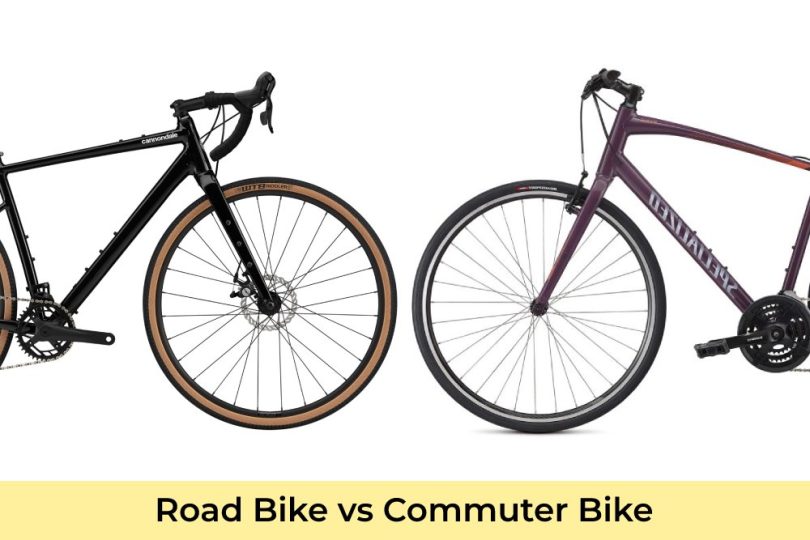Road bikes are designed for speed and efficiency on paved roads, while commuter bikes are designed for comfort and versatility on different types of terrain, including city roads and bike paths.
They both are designed differently for different purposes. If you’re not sure what to choose between the two, follow our guide!
What is a road bike?
Road bikes are designed to deliver speed on smooth and paved surfaces, such as city roads. They feature an aerodynamic frame, narrow tires, handlebars positioned downwards, and lightweight materials. All these features accentuate the core purpose of the road bike — agility.
Road bikes are faster than commuter bikes. A standard road bike has a speed of 15 mph (25 km/h) while a commuter bike can cover 12 mph (20 km/h) on average.
Road bikes come in different forms, including:
- Racing or performance bikes: lightweight and aerodynamic, designed for maximum speed and efficiency in road races and other high-performance riding.
- Endurance or sportive bikes: slightly heavier with a more relaxed geometry, they’re designed for longer rides with a focus on comfort and stability.
- Aero bikes: similar to racing bikes but with a focus on aerodynamics and reducing drag, making them faster in time trials and other events where aerodynamics is a key factor.
- Gravel or adventure bikes: designed for unpaved roads and rough terrain, gravel bikes have a more relaxed geometry and wider tires for improved stability and comfort.
- Touring bikes: designed for long-distance, multi-day rides with the ability to carry stuff, they have a more relaxed geometry, strong components, and mounting points for racks and other accessories.
What is a commuter bike?
As the name suggests, a commuter bike is used as a comfortable mode of transport to and fro work or other short trips like grocery shopping.
To optimize your comfort level, commuter bikes have wider saddles, a frame that optimizes posture, an upright seating position, and wide tires to absorb bumps.
Heavy tires alongside suspensions also aid the protection, which add to the bike’s overall weight and stability. Commuter bikes are therefore great for non-athletic cyclists who want a good bike for daily use without compromising comfort.
Commuter bikes can be categorized into:
- Hybrid bikes: a combination of road and mountain bikes, hybrid bikes are designed for urban commuting and general-purpose riding, with a focus on comfort and versatility.
- City bikes: also known as urban bikes, these bikes are designed specifically for urban commuting, with features such as upright handlebars, step-through frames, and often built-in lights and locks.
- Folding bikes: designed for portability, folding bikes can be easily folded up and carried in public transportation, making them ideal for commuters who need to travel with their bikes.
- Electric bikes: equipped with a battery-powered motor that provides assistance when pedaling, these bikes are designed for commuting and other forms of urban riding, making it easier to cover long distances and tackle hills.
- Cargo bikes: designed for carrying heavy loads, they have large cargo platforms or baskets for people who need to transport goods, such as groceries.
Pros and Cons of Road Bikes and Commuter Bikes
Road Bikes
Pros
- High speed and maximum agility
- Aerodynamic and lightweight
- Improved posture for easy breathing and reduced back and neck pain
- Limited drag force and rolling resistance
- Trains upper body muscles and leg muscles
Cons
- Most don’t have suspensions
- Suitable for paved roads only
- Not suitable for beginners
- Comparatively expensive
- High maintenance
Commuter Bikes
Pros
- Convenient and versatile
- Easily affordable
- Frame optimizes comfort and posture protection
- Suspension system included
- Great for beginners
Cons
- Slower than road bikes
- Less aerodynamic
- Comparatively heavier
Road Bike vs Commuter Bike: How They Differ
Design and frame
Road bikes have more complex aerodynamic frames while commuter bikes come with simple aluminum frames in most cases. Since road bikes are catered towards regular cyclists and athletes, they usually have a thin and lightweight frame with narrow wheels.
The handlebars are positioned towards the ground to channel the strength of the upper body muscles. Plus, the seating position keeps you in a forward leaning position that helps train your leg muscles.
While road bikes provide both a workout and a mode of transport, commuter bikes maximize comfort. They have wider saddles, straight handlebars, and wider wheels. All these keep the user at a relaxed posture while also helping them move from point A to B.
Weight
The weight of a road bike can range from as light as 13 lbs for a high-end, carbon fiber race bike to as heavy as 20-22 lbs for an entry-level aluminum road bike.
A commuter bike’s weight can vary based on the material, design, and components used. On average, a typical commuter bike weighs between 20-40 lbs.
Lightweight aluminum frame bikes can weigh as little as 15-20 lbs, while more sturdy steel frame bikes can weigh 30-40 lbs or more.
However, electric commuter bikes with a motor and a battery can weigh between 35-60 lbs or even more.
Speed
Road bikes are designed for speed and efficiency on smooth roads. The average road bike can reach 20-30 mph and can go even faster for experienced riders.
Since commuter bikes are for everyday use, speed is not a focal point here. A commuter bike can cover 15-20 mph though this varies based on your fitness level, the terrain, and the type of commuter bike you own.
Some electric commuter bikes can reach up to 28 mph, thanks to the added power of the electric motor.
Comfort
The more aggressive riding position of road bikes allows for maximum aerodynamics and efficient transfer of power to the pedals, but is not comfortable for longer rides.
Some road bikes have a more relaxed geometry to make them a little more comfortable. But they may not be as fast or efficient as the more aggressive road bikes.
On the other hand, commuter bikes have a more upright riding position, which is easier on your back, neck, and wrists. Their wider tires and a more relaxed geometry help absorb bumps on the road.
Wheels
Road bikes have narrow, lightweight wheels with high spoke counts, which allows for better aerodynamics and helps reduce wind resistance. The wheels also have a more rounded profile with little to no tread, which is better for maintaining speed and handling.
Since commuter bikes are designed for everyday use and practicality, they often have wider, heavier wheels with a more flat profile, which provides better stability and traction, especially on rough or uneven roads.
Durability
Road bikes are often designed for performance and speed. As a result, they sometimes have to compromise durability in order to save weight. The lightweight materials (e.g. carbon fiber and aluminum) are more susceptible to damage than the heavier and more durable materials like steel.
Also, road bikes often have more delicate components, such as lightweight pedals and derailleurs.
However, commuter bikes are designed with durability in mind. They are often made of heavier, more durable materials like steel and equipped with components designed to handle the wear and tear of daily use.
Price
High-end road bikes with carbon fiber frames and premium components can cost you several thousand dollars, while entry-level bikes made of aluminum frames and more basic components can be purchased for several hundred dollars.
Commuter bikes also have a wide range of prices, but they won’t break your banks like the high-end road bikes. They can range from under $300 for basic models to several thousand dollars for the high-end ones with advanced features and components.
Road Bike vs Commuter Bike: What to Choose:?
Commuter bikes are good for beginners, non-athletes, and even the elderly. These bikes are great for maximum protection, comfort, and reliability. So, if you’re looking for a practical and versatile bike for everyday use, a commuter bike would probably be a better fit.
But if you want to go fast and cover long distances on smooth roads, a road bike might be the best choice for you.
FAQs
Q. Can I use a road bike for commuting?
Ans. Road bikes are not designed for daily commute but many still use them to quickly get to and from their workplaces. You’ll be fine with a road bike if there are paved roads only.
2. Can commuter bikes be used off-road?
Ans. Commuter bikes are usually designed for paved roads but if you use a commuter bike off-roads on a regular basis, then it won’t last long.









